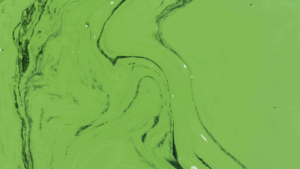by Paige Jessup, Climate Change Resiliency Intern
Cyanobacteria, or “blue-green algae”, are one of the old living organisms on earth, evolving from a group of microbes approximately 2.7 billion years ago. Cyanobacteria are thought to be the cause of one of Earth’s mass extinctions called “The Great Oxygenation Event” which took place between 2.4-2.1 billion years ago and wiped out almost all life on earth (Aiyer, 2022). Cyanobacteria survived this extinction and eventually went through a process called “endosymbiosis,” which is a symbiotic relationship where one organism lives inside the other (Kodama et al., 2010). This became the ancestor of plant cells, and cyanobacteria became chloroplasts which are the organelles that carry out photosynthesis.
Cyanobacteria play a critical role for many life cycles, so why do they have such a bad reputation today? The short answer is because of the toxins that many species produce called cyanotoxins. These toxins can cause numerous health effects ranging from minimal (diarrhea, headaches, skin irritation) to life threatening (death). Cyanobacteria blooms are also responsible for loss of water quality and decline in numerous populations of aquatic organisms (fish, amphibians, reptiles, birds, and mammals) due to the rate at which the cyanobacteria can reproduce.

Cyanobacteria occur naturally in most lakes, ponds, streams, and rivers in small quantities that are not usually visible to the naked eye (Government of Nova Scotia, 2025). In these small quantities they do not cause damage to the ecosystem and can actually be beneficial to those above them in the food chain depending on the species. However, under the right conditions, they will multiply and cause large blooms. This is when they can be dangerous.
There is a long history of cyanobacteria in Canada but over the past decade there has been a period of significant shoreline development and implementation of recreational water quality monitoring and surveillance programs. These means we are able to see in real-time how prominent they have become. Historically, cyanobacteria have been prominent across the provinces of Alberta, Saskatchewan, and Manitoba where phosphorus-rich sedimentary bedrock predominates within these landscapes (Zurawell et al., 2023). Gradually over the years, they are becoming more prominent with the rise of anthropogenic activities such as agricultural runoff, invasive species, carbon dioxide pollution, shoreline development, and effluent from sewage treatment plants.
The increase in public awareness of blue-green algae has in turn led to an increase in monitoring and reporting, protection of drinking water sources, reduced nutrients that promote the growth of algae, support of science to better understand algal blooms, and administration of legislation, regulations, policies and programs to protect water quality (Government of Ontario, 2022). Remediation experiments are also underway, such as a University of Alberta study which is examining the possibility of adding iron to lakes infected with cyanobacteria.
It is important to remember that if you see something, you need to say something! Take the time to learn how to identify blue-green algae blooms and report one if you think you have spotted one. You may possibly stop someone from being exposed to fatal toxins in the water.
This blog is part of a larger education toolkit about cyanobacteria. To access all of the resources from the toolkit, visit watersheds.ca/cyanobacteria
References
Aiyer, K. (2022, February 18). The Great Oxidation Event: How Cyanobacteria Changed Life. American Society for Microbiology. Retrieved from https://asm.org/articles/2022/february/the-great-oxidation-event-how-cyanobacteria-change
Government of Canada. (2024, June 13). Recreational water and health: Cyanobacteria and their toxins. Retrieved from https://www.canada.ca/en/health-canada/services/environment/recreational-water/cyanobacteria-toxins.html
Government of Ontario. (2022). Blue-green algae. https://www.ontario.ca/page/blue-green-algae
Government of Nova Scotia. (2025) Blue-green algae. Retrieved from https://novascotia.ca/blue-green-algae/
Kodama, Y., Fujishima, M. (2010). Secondary Symbiosis Between Paramecium and Chlorella Cells. International Review of Cell and Molecular Biology. 279, 33-77. doi:10.1016/S1937-6448(10)79002-X
Zurawell, R., Graydon, J. (2023). Cyanobacterial Blooms and Recreational Water Quality Monitoring in Canada. North American Lake Management Society. Retrieved from https://www.nalms.org/wp-content/uploads/2023/07/43-2-5.pdf
This piece is part of an education toolkit generously funded by:

